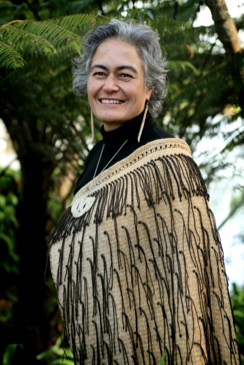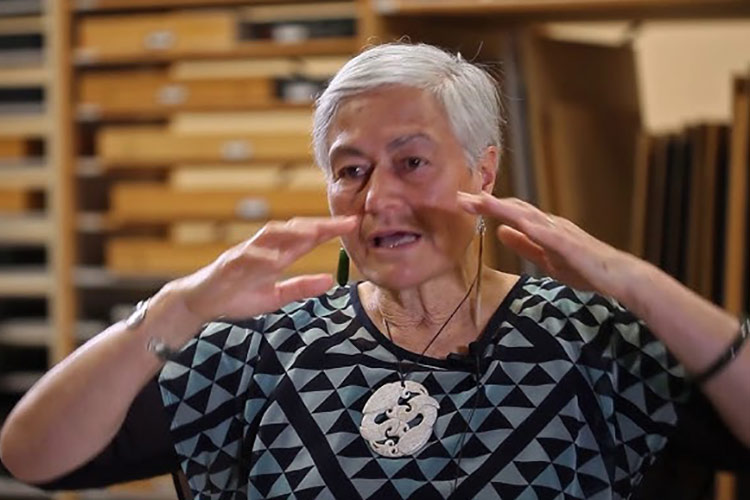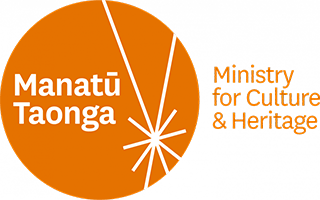
Dr Aroha Yates-Smith is a New Zealand performer and academic, who affiliates to Te Arawa, Tainui, Takitimu, Horouta, and Mataatua.[1] She is known for her research into forgotten Māori female deities.
Dr Aroha Yates-Smith
Te Arawa, Tainui, Takitimu, Horouta, and Mataatua.
Early life and education of Dr Aroha Yates-Smith
Yates-Smith grew up in Rotorua.[2] As a child, she had wanted to know why there was a lack of stories about female Māori goddesses.[3] Yates Smith completed a Masters degree and taught the Māori language before undertaking a PhD to look for lost stories of Māori female deities.[3] She completed her thesis, titled Hine! e Hine!: rediscovering the feminine in Maori spirituality, at the University of Waikato in 1998.[3] The thesis examines the role of atua wahine (female Māori goddesses) in the Māori world view, and the marginalisation of the feminine, both past and present.[4]
Dr Aroha Yates-Smith Career
Yates-Smith became Dean at the University of Waikato’s School of Māori and Pacific Development (Te Pua Wānanga ki te Ao). Her research interests have included Māori spirituality, traditional Māori medicine.[3] She is also interested in Māori women’s arts and crafts, and the tradition of karetao (Māori puppetry), which she hopes to revive.[2]
Yates-Smith curated an exhibition, including her own work, at the Rotorua Museum in 2000. The exhibition, Hine! E Hine!, was funded by the Arts Council Te Waka Toi (now Creative New Zealand), and explored the legacy of Māori women.[2] She has featured on a number of recordings, including collaborating with Hirini Melbourne and Richard Nunns on the DVD Te Hekenga-ā-Rangi in 2003.[2] The soundtrack was later released as a CD titled Karanga Te Po – Karanga Te Ao, and featured traditional Māori musical instruments taonga puoro.[5] She has composed work and done vocal work including the DVD Tau te Mauri Breath of Peace, which won the Sonja Davies Peace Award in 2005, and the 2007 film He Oranga He Oranga Healing Journeys, which received a Commended World Peace Film Award at the World Peace Film and Music Festival in Lucknow, India.[2]’
Yates-Smith’s work was the inspiration for the video game MāoriGrl by her daughter Kahurangiariki Smith, and the digital exhibition of the same name held in the Depot Artspace in Devonport in 2018.[6] The exhibition reinterpreted the story of Hine-tītama /Hine-nui-te-pō, the woman who became the goddess of death in Māori mythology.[1]
Honours and awards
In 1992 Yates-Smith won a Fulbright Scholarship to visit the East–West Center at the University of Hawai’i in Manoa.[2]
In 2003 Yates-Smith was awarded the Te Rangi Hiroa Medal, which is awarded for “current issues in cultural diversity and cohesion”, for her doctoral thesis.[4] In 2017, she was selected as one of the Royal Society Te Apārangi’s 150 women in 150 words.[3]
Selected works by Dr Aroha Yates-Smith
- Te Hekenga-ā-Rangi, Performer: Hirini Melbourne, Richard Nunns, Aroha Yates-Smith, Steve Garden, New Zealand
- Tau te mauri = breath of peace, 2005
- Gillian Whitehead; Ben Hoadley; Aroha Yates-Smith; Richard Nunns; Janet Roddick; Emma Sayers; Stephen De Pledge; Tuhonohono (Musical group) (2004), Arapātiki,
- He oranga he oranga = Healing journeys, 2007
Podcast featuring Dr Aroha Yates-Smith
- “Emerging artist brings atua wāhine (Māori Goddess) story to life with immersive digital installation for Matariki 2018”. The Big Idea. 14 June 2018. Archived from the original on 4 February 2021. Retrieved 28 January 2021.
- ^ “Aroha Yates-Smith”. www.sounz.org.nz. Archived from the original on 1 February 2021. Retrieved 28 January 2021.
- “Aroha Yates-Smith”. Royal Society Te Apārangi. Archived from the original on 1 February 2021. Retrieved 28 January 2021.
- “Waikato Academic Honoured For Thesis”. www.scoop.co.nz. 22 November 2004. Archived from the original on 1 February 2021. Retrieved 28 January 2021.
- “Celebration of music inspired by the top of the south”. Stuff. 19 September 2016. Archived from the original on 1 February 2021. Retrieved 28 January 2021.
- “Playing with the goddess of death for Matariki”. RNZ. 5 July 2018. Archived from the original on 14 February 2021. Retrieved 28 January 2021.


